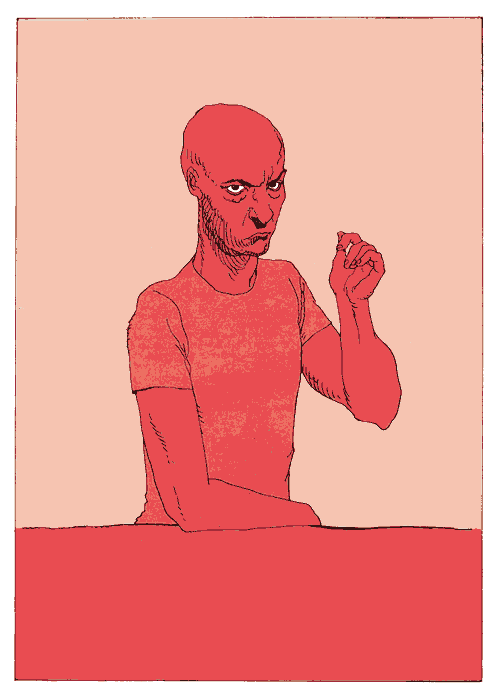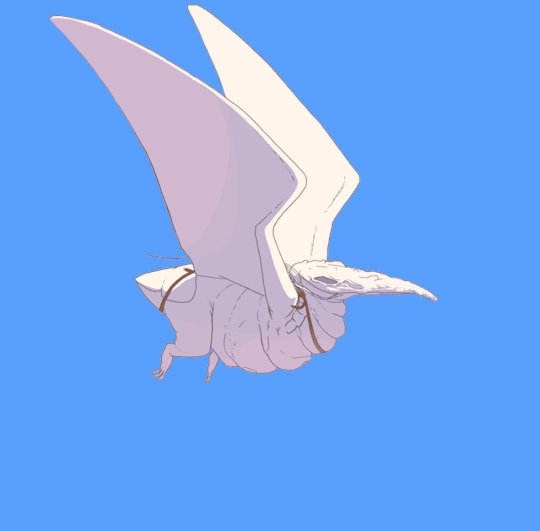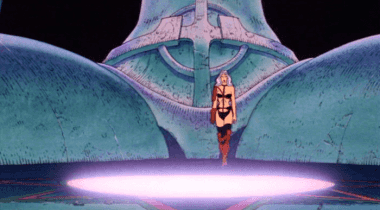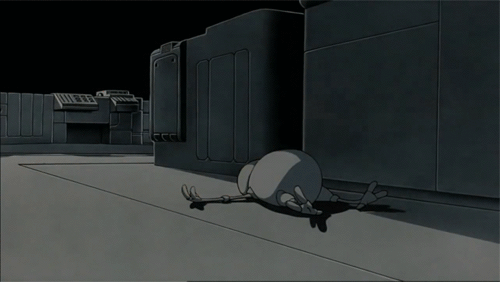originally posted at https://canmom.tumblr.com/post/662514...
Ahoy friends! It is Thursday once again. I am running late for Animation Night. Novel…
Tonight the theme for Animation Night is actually a comics guy rather than an animator. But it’s like, the comics guy.
Jean Giraud, best known by his pen name Moebius, is no question one of the most influential comics artists and sci-fi illustrators of the 20th century. If you’ve been following me a while, you may well have seen me reblog posts by @everydaymoebius - go there and scroll a bit to get a sense of his style.

(The frames of this animation were originally panels in one of Moebius’s comics - this is perhaps as close as I can get to showing his animation!)
So. I definitely do not have time to recap all of Moebius’s career and in any case someone at Wikipedia already did that, but let’s try and give a very brief intro. Moebius worked in the fascinating Franco-Belgian comics tradition (bandes dessinées). That tradition is mostly associated with the schematic ligne claire side of e.g. Tintin, but Moebius is another pole: a lavishly illustrated form of realism, most often used in science fiction comics, which apparently dates back to Jjjé (Joseph Gillain).
Bandes dessinées are a curious thing, representing the usual of the extremes of French art. On the one hand, they have some of the most beautiful, lavish, creative illustration anyone has ever made in comics; look at Enki Bilal’s work sometime and just have your breath expelled from your body. On the other hand, there’s the racism thing! For whatever reason, the particular path France has taken in relinquishing its hold on its colonies (their brutal rule of Algeria was famously described by Fanon) has led to, well, images that would be outrageously out of line over here seemingly passing without comment over there. If you get into BDs, you’re gonna see some shit, both good and bad.

(a Moebius-inspired animation, based on his character Arzach)
So where did Moeb come from? I was curious about this, so that’s the bulk of our post tonight. The tl;dr is he came up through Western comics (as in, cowboys)…
The babby Moebius grew up with his grandparents watching Westerns in Paris during the years of post-WWII reconstruction, and he began drawing comics at a young age, about 9-10. At age 16, he went to art school; at this point, comics were yet to attain their current revered place in French culture as (oh my god this is so wanky) the Ninth Art, and his teachers were not impressed, but he became close friends with another future comics artist, Jean-Claude Mézières.
Giraud did not actually graduate art school, but departed to Mexico to stay with his mother for nine months; there, he witnessed the sight of the desert up close, and this was apparently very formative, often discussed in his interviews. On his return, he made his debut in the comics industry drawing Westerns, inspired by Morris (Maurice De Bevere)’s Lucky Luke. Ironically, at the time the editor of the magazine Marijac (Jacques Dumas) advised him to focus his efforts on humour comics, saying he had ‘no talent whatsoever’ for realism.
Fortunately, young Jean disregarded this advice and continued to draw realistic Western comics on the side, and eventually managed to get an apprenticeship with his idol Jijé, who had a habit of training young artists. He got something of a sharp awakening with the much harsher schedule, but inked a number of Jijé’s comics, particularly an arc of Jerry Spring.
Even though Giraud did lose touch with his mentor eventually, he never forgot what “his master” had provided him with, both “aesthetically and professionally”,[26] the fatherless Giraud gratefully stating in later life, “It was as if he had asked me «Do you want me to be your father?», and if by a miracle, I was provided with one, a[n] [comic] artist no less!”.[24]
After his stint with Jijé, Moebius got a job in historical illustration for the publisher Hachette - meeting Claudine Colin, an editorial researcher who he would go on to marry. This is where he began working in science fiction illustration and started developing the Moebius alter-ego, briefly writing satirical comics for a publication called Hari-Kiri, a predecessor to the infamous Charlie Hebdo.
Before too long, though, he was pulled back to non-pseudonymous comics to work on Pilote magazine with Jean-Michel Charlier, beginning with a series called Fort Navajo. Once again, Giraud struggled to meet the demanding schedule; at one point he had a breakdown and Jijé stepped in. But he managed to keep working, pouring more and more effort into his Westerns.
The most notable of these is the series Blueberry, which permitted him to develop a much grittier visual style and adopt more ‘adult’ themes than the majority of Western comics at the time. By this point there’s no question that Moebius can draw really quite extremely astonishingly well. I mean look at that shit. This series happened to coincide with the May ‘68 social upheavals in France (the Situationists etc.), and while the French did not achieve communism, it did give Moebius and other comics artists a chance to push the editor, the conservative René Goscinny of Asterix fame, for a lot more editorial freedom.
Then Jodorowsky came along.
Alejandro Jodorowsky is a… challenging movie director and science fiction-occultism-etc. kind of guy. So what’s the deal? Let’s put it this way… the guy’s really fucking obsessed with talking rape and portraying most parodically extreme masculinity; he’s one of those occulty guys and there’s some… fascinatingly weird shit in his comics like The Metabarons. But he’s also friends with just about all the big names in the industry at that time, which means he’s worked with some really incredible artists, and along the way directed some really renowned films like The Holy Mountain (1973); but equally he is infamous for claiming to have raped the lead actress for a scene in his film El Topo (1970), though he later claimed this was just an edgy lie he made up to get attention as a foreign director.
Whatever the truth is, he struck a strong friendship with Moebius. In 1974, Jodorowsky was attempting to adapt Dune, and to that end he invited all the great French comics artists he knew, among them Moebius, to work on the project. Its failure has gone down in film legend, but its lasting effect is significant: many of the French artists gathered for the film went on to design the look of genre-defining films like Star Wars and Alien. Moebius was among these artists, working on Alien, and took the opportunity to attempt to revive and expand his science fiction persona. Around that time, Jodorowsky introduced Moebius to Carlos Castenada, who wrote a series of books about shamanistic training that he supposedly received.
During Dune, Moebius occasionally returned to France, reviving his Moebius name to create Western comics with a much more explicit social critique than his main Western comics regarding Native genocide. This was soon followed by his first substantial sci-fi publication as Moebius, a goofy sex comedy story called “Le bandard fou” (“The Horny Goof”) about a man pursued across space by what the Wiki calls ‘puritanical authorities’ for having an erection; it was controversial at the time for whether it was True Art or just porn (the answer seems to be ‘whatever it’s both’).

When Dune fell through, Giraud returned to France, joining with other artists from Pilote to create an organisation called Les Humanoïdes Associés who would publish an experimental science fiction magazine Métal Hurlant (Screaming Metal), which was republished in English as Heavy Metal.
And this is where his career as Moebius really begins, with some of his most famous works like Arzach (a wordless story about a guy in a tall hat riding a pterodactyl) and The Airtight Garage of Jerry Cornelius (leaning into the sort of surreal Michael Moorcock-inspired sci fi, a chaotic but beautiful, improvised story about a guy in a pocket universe inside an asteroid. (Moorcock apparently liked the series, but due to a miscommunication, Moebius got the impression he was unimpressed and later renamed the Jerry Cornelius nod to ‘Lewis Carnelian’). This also saw ongoing collaborations with Jodorowsky like the structurally experimental The Eyes of the Cat and The Incal, helping to establish Jodorowsky’s new career as a comics writer.
As Moebius, he quickly started getting a massive international reputation thanks to his incredibly inventive stories… and, of course the new art style he was developing, which carried over the anatomical realism of the Western comics but pushed it to a kind of really poised elegance, with really clever use of white negative space contrasting with the precise detail of the linework. Some of his hallmarks are gigantic, intricate crowd scene panels packed with interesting-looking characters, and his use of zippertone dots to create very neat shading. His pictures just pull you in…
There’s a cute anecdote from around this period, whose source I haven’t had find to track down, so I’ll give you @lyravelocity‘s telling:
I think my fave moeb anecdote is where a young fan asks for his autograph, gets it, then he asks if moebius can draw the star watcher, you know the girl w the tall hat and the box? So old Jean does a gorgeous little pencil sketch of the star watcher next to his signature, the kid asks like, can you ink it for me Mr moebius? And moebius takes a sharpie and inks it, totally murders the subtlety of the drawing and says to the kid “see? You have learned it is possible to ask too much!”
Moebius did a lot more in his life, including a stint in American comics, but since this takes us up to the films I’m planning to show tonight, I’ll leave the history there - it’s Animation Night not Comics Night after all :p

So how does Moebius come into animation? (Apart from, of course, extensively inspiring Hayao Miyazaki and other inventive sci-fi mangakas.) To my knowledge, he’s directly worked on an animated film only once, joining René Laloux of Fantastic Planet (La Planète sauvage/Divoká planeta) fame. Laloux is a filmmaker I’m long overdue to cover, so I’ll save the detailed history for when it’s his turn in the spotlight, but Moebius joined him to create designs for his second animated film, The Masters of Time (Les Maîtres du temps) - which Wikipedia describes as a “Franco-West German-Swiss-British-Hungarian” collaboration. Phew.
This movie is a little frustrating to research, though - beyond the fact that Moebius worked did most of the production design and a very detailed plot summary, I can turn up almost nothing about its production.
What I can confirm though is that it looks absolutely gorgeous, carrying Moebius’s stark compositions and organic designs to create something really lovely looking. The story portrays a group of space travellers on a rescue mission going through a series of surreal settings, such as being sucked into an amorphous planet control gestalt entity. I’m certainly looking forward to discovering what is up with it.
The second film I have did not involve the direct involvement of Moebius, but draws heavily on his work: the Canadian-American production Heavy Metal. As we discussed, Metal Hurlant became quite popular outside of France, and eventually the translated version in America, Heavy Metal, started publishing their own original works on the general theme of ‘dark sci fi’. At some point, they got the idea to adapt some stories into an animated film, which was duly released in 1981.
The film is mostly notable for being… very edgy and grimdark lol, like sexual violence warning etc. It portrays an evil artefact that gets passed through a series of short vignettes, two of which are based on Moebius comics: his The Long Tomorrow became a segment called Harry Canyon, and Arzach became a segment called Taarna. The film, like many fantasy films of the period such as Bakshi’s, makes extensive use of rotoscoping in the animation; split between many different production houses, it may be something of a mixed bag, but I’ve been curious a long while and I’m sure there are some good stories in there! (It’s also a major inspiration for Netflix’s anthology Love, Death and Robots.)
So that’s the plan tonight: Heavy Metal (1981) and The Masters of Time (1982). Sadly the latter does not seem to be available in HD anywhere, so we’ll have to bear with a DVDrip, but hopefully a legible one lol. I’ll be starting very soon at twitch.tv/canmom - would love to see you there!
Comments